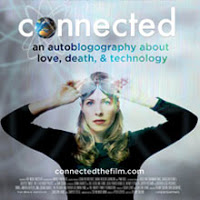#TMRTE 2012: Dancing with Ourselves

When a friend suggested I create a Twitter account in 2008, I resisted. In fact, I said, 'Steve, I like you a lot but I don't give a flip what you had for breakfast, so nope.' He laughed and patiently said, 'Open an account today and I'll introduce you to 12 incredible people you will never meet.' I did. He did. And he was right. Until I reached 4000 followers.
This morning at The Market Research Technology Event, filmmaker Tiffany Shlain elevated the discussion regarding the digital lifestyle to declare that we're entering a state of digital connectedness never before seen. Her premise is that this will create a 'DaVinci style Brain Synthesis' that raises human existence to higher levels of thoughtfulness, inclusiveness and even quality. Her film Connected: an autoblogography about love, death and technology provoked a question from the audience about how there would ever be another world war in this state of global connectedness. Good question.
This brings me back around to Steve's breakfast. Shlain has done a masterful job of harnessing the best of the web, bringing together disparate audiences to co-create content and give us an optimistic point of view regarding the state of humanity and what the future promises. The problem is that most of what crosses my radar in social media is Foursquare check-ins, random observations, overt hocking of products by and for brands and yes, what people had for lunch. All of this makes me wonder if the 'river of news' when used for market research observations is really just a narcissist's playground. Maybe it's not so much that we are connecting with each other, as it is each of us simultaneously talking about ourselves to no one. Maybe we are all dancing with ourselves.
Lenny Murphy (Greenbook.com) disagrees with me. He believes the social media market is self monitoring and that those who are narcissistic are 'weeded out.' When Lenny speaks, I listen. And I agree with him to a point and this made me think harder. While it's largely true that a lack of interaction (or being a complete tool) will eject you from a group, that group still does not have the power to shut me up on Twitter or close my account on Facebook. There's nothing to stop the one sided conversations ' think about the guy walking around with the Bluetooth in the airport who looks like he's talking to himself ' that's my perception of much of the content we're analyzing.
That said' what's brilliant about Shlain's work is that while she crowdsourced the raw input but applied an expert interpretation to the massive amount of input. It's called film editing. As Market Researchers we are all editors, sifting through imposing amounts of information to find insight and meaning. So, how to find what's useful from social media? Market Researchers tend to look for the big implication, the most broadly appealing idea, the strongest driver, etc. We think big. Another way to think about editing is to think small. Consider for a moment that 90% of what comes into view via social media is total garbage. How do you find the 10% that inspires, provokes and informs? How do you find the bit that doesn't fit?
A week after I joined Twitter in 2008 I wanted to use it for research. This was before mobile research tools were well developed and I just wanted to experiment to better experience this new toy for myself. I partnered with C&R Research to develop a tool called Twitter Slicing. We created a Twitter handle for me (which was really an early form of bot ' my first virtual me) and recruited 300 people who joined Twitter and agreed only to tweet with me for one week on their mobile device. We sent out the same tweet ten times a day: 'Are you chewing gum right now, if not, why not'? (company not named but this experience is shared with client permission). After 5 days we had 15,000 responses to one question. Coding with both traditional methods and text analysis suggested that 90% of the responses were pure crap. 'I didn't feel like it.' 'I didn't have any gum.' 'I'm not answering this question again so shut up.' But there were a few responses regarding reluctance to share gum with others, gum stuck to the paper, and noisy wrappers. These were the nuggets we'd typically call insights. But instead of huge findings, they were actually more like grains of sand. It's the type of stuff that makes you say, 'huh'? And that inspires innovation.
As Shlain suggested that editing is interpreting raw material with a point of view. Good editors parse through piles of chaff to find a germ of truth and present it in a compelling, engaging way. This is what truly excellent Market Researchers do. They find the grain of sand and that make business partners say "wow."
-------------------------------------------------
Today's guest post is from Kelley Styring. Styring is principal of InsightFarm Inc. a market research and consumer strategy consulting firm. She has led insights for Procter & Gamble, Pepsico, Black & Decker and NASA prior to founding her own firm in 2003. Kelley is a published author and has been featured in USA Today, ABC News, Good Morning America, Brandweek, Fortune, Quirk's Marketing Research and The Market Research Daily Report from RFL Online. She will be live blogging from TMRTE in next week in Las Vegas, April 30-May 2, 2012.
